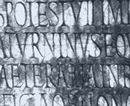
1. Aim
The collection and edition of classical Latin inscriptions, which, as direct evidence, are indispensable in researching the history and everyday life of ancient Rome.
2. Overview
a. Epigraphic research
Inscriptions, as direct evidence from the ancient world, are among the most important sources for investigating Roman history and everyday life in all their aspects. In every period when the legacy of the classical world has been consciously sought out, inscriptions have therefore been collected and edited. From the Carolingian period we have a collection of Latin inscriptions in the codex Einsidlensis; above all in the Renaissance scholars put great efforts into preserving inscriptions in comprehensive corpora. The collections made in earlier periods, by such famous names as Cola di Rienzo or Scaliger, no longer met the different scholarly standards of a modern critical edition and, as the number of inscriptions grew steadily, they were soon out of date. In the following period individual researchers, for example Gaetano Marini, put in admirable efforts but were unable to deal with the quantity of material. In 1815 the ?Royal Prussian Academy of Sciences? therefore formed the plan of publishing the classical inscriptions, first Greek, then Latin, in comprehensive collections.
Under the direction of Theodor Mommsen, the Corpus Inscriptionum Latinarum was formed in 1853 and the first volume appeared ten years later. By the outbreak of the First World War the majority of Latin inscriptions from the classical period which were known at that time had been published. This project of Mommsen's, continued by his students in collaboration with scholars from the countries where the inscriptions were found, was internationally recognised as a major achievement. Thereafter financial problems, the isolation of Germany after the First World War and the political situation in East Germany after the Second World War all had a negative impact on the work of the CIL. Thanks to the CIL's high standing in the international scholarly world, many researchers and institutions in West Germany and further afield took on financial and scholarly responsibilities in the epigraphic research after 1945. The CIL at first operated as an independent project within the Berlin Academy of Sciences, then, from 1955 to 1991, it was attached to various institutes of the academy. After a complicated transitional phase the project has been, since 1994, under the aegis of the Berlin-Brandenburg Academy of Sciences. Since the reunification of Germany the collaboration with colleagues abroad which in earlier times had been taken for granted has also been intensified. At present, the CIL cooperates not only with German epigraphers, but also with researchers from Austria, the Czech Republic, Finland, Hungary, Italy, Portugal, Spain, Sweden and Romania.
b. Scope
The CIL includes the Latin inscriptions from the entire area of the former Roman empire, arranged by region and by inscription-type. Since its foundation by Theodor Mommsen it has been the standard edition of the epigraphic legacy of ancient Rome. The Berlin research centre is responsible for the continuation of this work. International collaboration is indispensable and the Berlin team coordinates the efforts of a large number of international researcher and prepares for publication the work they send in, along with research produced in-house. New discoveries and corrections to previously published inscriptions are edited in second editions and supplementary volumes, so that the Corpus is continuously up-dated and expanded. However, to fulfil the aim stated above, the Berlin centre cannot restrict itself to editorial work, although this remains its principal task. It is also necessary to maintain a continuous survey of the scholarly literature on Latin epigraphy and to produce bibliographic updates to the Corpus. The Bibliography of Latin Epigraphy which has been maintained since 1950 (now as a Filemaker database) contains over 30,000 titles; in addition there is a separate index of references in recent publications to inscriptions published in CIL and other collections. Along with manuscripts and excerpts of previously published inscriptions and an extensive collection of epigraphic squeezes, these are a frequently-consulted information source. They are also a research resource of exceptional value which can be used by individual scholars preparing their own corpora.
c. Review and Outlook
At present, the CIL has 17 volumes in around 70 parts in folio-size editions, holding around 180,000 inscriptions, along with 13 supplementary volumes with illustrations and specialised indices. The edition of the inscriptions is based on an examination of the originals, considering also manuscript and printed sources. As well as the inscriptions and the accompanying documentation of their archaeolgical context, the volumes contain summary bibliographies, information on the ancient communities in which the inscriptions were found, name- and subject-indices with detailed subdivisions, and maps and town-plans. Until recently, a selection of photographs and drawings were presented as separate illustrations or on microfilm; some drawings were also included on the pages of text. The new volumes now present the transcriptions of the epigraphic text side-by-side with the photos and drawings in a single ensemble, allowing the reader to check the evidence and the reading against each other. In this way, the documentatrion now allows a critical approach to the text which was not possible in Mommsen's day. The staff of the Berlin research centre and colleagues elsewhere are currently working on supplements, new editions and first publications of 16 volumes in total, in numerous fascicles. For the most part, this work consists of the publication of inscriptions from Italy, Rome, the Iberian peninsula, Noricum, Dalmatia, Raetia, the German provinces of the Roman empire and the Carmina Latina Epigraphica. An account of the work in progress is provided in an annual report.





